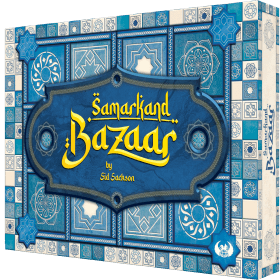Samarkand
 Een handelsspel waarin je geen handel drijft met de andere spelers. In plaats daarvan liggen de handelswaren op het bord in een aantal 'nomadenkampen'. Als je zet je bij een kamp brengt, moet je een geschenk aan het kamp aanbieden -- dan kun je je kaarten ruilen tegen alle kaarten in het kamp. Je kunt ook goederen van de stapel kopen op 'oase'-pleinen. Nadat je een aantal van een bepaalde grondstof hebt verzameld, ga je naar de stad waar die grondstof wordt gekocht. Er zijn nog een paar andere details om de zaken ingewikkelder te maken, maar in principe herhaalt iedereen dit proces totdat iemand de 500 cash in handen heeft om het spel te winnen. Samarkand is een entertainende oefening zonder bijzonder hersenbelastende strategieën om uit te vogelen en is een goed familiespel.
Een handelsspel waarin je geen handel drijft met de andere spelers. In plaats daarvan liggen de handelswaren op het bord in een aantal 'nomadenkampen'. Als je zet je bij een kamp brengt, moet je een geschenk aan het kamp aanbieden -- dan kun je je kaarten ruilen tegen alle kaarten in het kamp. Je kunt ook goederen van de stapel kopen op 'oase'-pleinen. Nadat je een aantal van een bepaalde grondstof hebt verzameld, ga je naar de stad waar die grondstof wordt gekocht. Er zijn nog een paar andere details om de zaken ingewikkelder te maken, maar in principe herhaalt iedereen dit proces totdat iemand de 500 cash in handen heeft om het spel te winnen. Samarkand is een entertainende oefening zonder bijzonder hersenbelastende strategieën om uit te vogelen en is een goed familiespel.
Dit spel wordt soms Bazaar II genoemd, omdat Schmidt Spiele dit spel oorspronkelijk uitgaf onder de naam Bazaar, hoewel Bazaar een volledig ander spel is. Beide spellen zijn van Sid Sackson.
Aantal spelers: 2 - 5
Spelduur: 20 mn
Complexiteit: 2 / 5
Speel Samarkand en 1184 andere spellen online.
Geen download nodig - speel rechtstreeks in je webbrowser.
Met je vrienden en duizenden spelers van over de hele wereld.
Gratis.

Speel Samarkand en 1184 andere spellen online.
Geen download nodig - speel rechtstreeks in je webbrowser.
Met je vrienden en duizenden spelers van over de hele wereld.
Gratis.

Samenvatting van de regels
Samarkand
An eastern trading game from Sid Sackson
SAMARKAND is a fast-paced merchant game set in the exotic East. Sparkling jewels and valuable carpets promise large gains, but copper and grain can also earn important profits. All merchants know where they can trade with Nomads and what goods they have available for those who are willing to offer gifts for their hospitality. They also know where to buy the wares they want for the best prices. Finally, these merchants know which bazaars in cities such as Samarkand or Isfahan offer the best prices for the goods they have to sell. The merchants know which desert paths to use to travel amongst the nomads, oases, and cities and so can plan their trips to be efficient and earn the largest profit for their travels.
Setup and Components
The game contains 102 commodity cubes
22 x grain (yellow cubes)
20 x fruit (green cubes)
18 x copper goods (red cubes)
16 x carpets (blue cubes)
14 x camels (white cubes)
12 x jewels (black cubes)
When playing with fewer than 5 players, reduce the number of commodity cubes:
• with 4 players remove 1 of each commodity
• with 3 players remove 3 of each commodity
• with 2 players remove 5 of each commodity
Each player will get a game figure, 200 Piaster (represented by their score), 7 random good cubes, and a price table. The first player is chosen and they place their player token anywhere on the board. In clockwise order, the other players follow suit and place their game figures on the game board. More than one player may start in the same space. After everyone places their players pieces, the start player then takes their first turn.
Gameplay
The players are merchants traveling the routes shown by the red arrows. With the Nomads they can trade the goods they have for those they want, in the oases they can buy new goods and in the bazaars of the large cities they can sell them for great profits. The more goods of one kind a player sells, the more money they can earn. With some luck when buying and skill when trading, a player will do well. A player who visits a Nomad camp with a full trading field will have a great opportunity.
The board has 3 types of spaces:
• the small NOMAD camps, where goods are traded
• the OASIS where goods can be purchased
• the CITIES where goods can be sold
Nomad camps
Each Nomad camp has a value of 4, 5 or 6 and has a trading field for the same number of cubes on the board. When a players enters a Nomad camp which does not have the maximum number of cubes on its trading field, the player must place a cube from their hand (as a greeting gift) on the field for that camp. If a player has no cube to give as a greeting gift, they must buy a commodity cube for 20 piasters and place it in the trading field for that Nomad camp. After giving (or buying) the greeting gift, the player may trade cubes from their hand for those available at the Nomad camp. To do so, the player simply selects the cubes they wants from the camp, and the cubes they want from their own supply, and makes the trade. The player can only execute a trade once, but can trade as many cubes as they want when they do.
If a Nomad camp already contains the maximum number of cubes (4, 5, or 6), the player must pay 10 Piaster and takes all the commodity cubes, which they add to their supply. Like at the beginning of the game, two new cubes are placed in the trading field for that camp.
Oasis
When a player enters an oasis, they must buy 1 or 4 cubes at the price indicated. They pay the money to the bank and draws 1 or 4 cubes.
If a player enters an Oasis and does not have sufficient money to buy even a single good, they must give up three of their cubes at random to the bank.
City
When a player enters a city, they must sell them at least two cubes of one of the two commodities they will buy, if they can. The player decides which of the two markets in the city they will sell to. The price table shows the prices the city (the bank) will pay for different numbers of goods. For example, if a player sells 5 grain [yellow cubes], the grain market will pay 40 Piaster. Cubes sold are put back into the bag and can be drawn again later.
Two of the city markets show a multi-colored swirl symbol. Such a market will only buy an assortment of goods. In fact, they will buy just one of each good. For example, they would pay 15 Piaster for 1 grain, 1 fruit and 1 jewel.
After the sale, the player covers the corresponding symbol with the purple disc. That commodity can no longer be sold until the disc is moved. The disc will move when another sale is made, at which point the disc will move to cover the newly sold good, allowing for the previous good to be sold again.
If a player enters a city and cannot sell the items the city’s markets will buy, they must pay 20 Piaster to the bank.
Movement
On a player’s turn they must decide from one of 3 possible moves:
1 space free of charge
The player may move their figure exactly one space in the direction of the arrows for no cost. They then take whatever action(s) allowed or required in the space they have reached.
Nomad camp extra move
When a player gives a greeting gift at an Nomad camp having moved 1 space free of charge, they may, instead of trading, move one additional space in the direction of an arrow. If they enter another Nomad camp, they may do the same thing, again after giving a greeting gift. When they finally end their movement, they then takes whatever action(s) allowed or required in the space they have reached.
Dice for 5 Piasters
The player pays 5 Piaster to the bank and rolls the special die. The player then moves exactly the number of spaces indicated on the die. They may only move in the direction indicated by the arrows.
When the backwards arrow is rolled, the player must move backwards (against the arrows) one space. When the arrows offer more than one choice, the player chooses which space to move to.
They then take whatever action(s) allowed or required in the space they have reached.
No more commodities
When the last commodity cube is drawn, each player must immediately reduce the number of cubes in their hand to 12 by discarding any over that number. These cubes are all returned to the bag, and the interrupted move is completed if it was incomplete when the goods ran out.
Game End / Winning the game
The first player to have 500 Piaster will end the game immediately and win!

